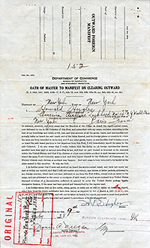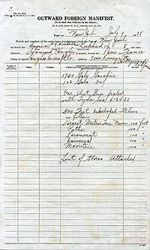
Outward Foreign Manifest, Side 1: Oath of Master. Manifest No. 152 was issued on July 9, 1938 for Howard Hughes, whose signature appears as Master.
On July 9, 1938, young millionaire, aviation entrepreneur and movie director Howard Hughes signed an Outward Foreign Manifest for his Lockheed No. 14 Super Electra plane, which was named New York World's Fair 1939 to promote the upcoming fair. On the form, he noted enough gasoline and oil to get him and his four-man crew to Paris, France, on the first leg of a round-the-world tour. Francis A. Meegan, deputy collector for the Port of New York, certified the manifest.
At 7:20 p.m. on July 10, the plane took off from Floyd Bennett Field on Long Island. Three days, nineteen hours, eight minutes and ten seconds later, the New York World's Fair 1939 touched down at Bennett Field once again, shattering previous records held by pilots Charles Lindbergh and Wiley Post. Hughes and crew racked up 14,791 miles in their circuit to Paris, Moscow, Omsk, Yakutsk in Siberia, then back to North America with stops in Fairbanks, Alaska and Minneapolis, Minn., before returning to their starting point.

Outward Foreign Manifest, Side 2: Report of Cargo. The "List of Stores" is not attached to the Hughes manifest, but we can speculate on what he carried based on his advance requests for the landing sites.
When such daring pilots' planes crossed our borders, U.S. Customs and Border Protection's legacy agencies played a role. Aircraft leaving American airspace needed to declare to Customs what they were taking with them. Likewise, flying into the country required inspections upon landing to certify that all was as it should be. This was equally true for globe-hopping record-breaking flights passing through America from other nations of origin.
The plane was equipped with the latest in radio transmission, navigation, emergency beacon, and other equipment. Newspapers of the day reported that "Secret Army Aviation Devices" were on board, tracking measurements over foreign territory. Even more than his record speed, Hughes was proud that he proved the capabilities of these new technologies. The flight also demonstrated the potential for commercial transoceanic ventures, which were feasible if shorter flight times, continuous communication and more reliable navigation became the norm.

A map detailing the advance planning necessary to pass over or land on foreign soil. In a race for a world record, prior arrangements for food, fuel and any needed repairs were essential to minimize time on the ground at each stopover.
A huge crowd greeted the Lockheed as it taxied to a stop at Floyd Bennett Field on July 14. Before the crew enjoyed their public accolades, though, inspectors from Customs, Immigration and Naturalization, Health and Agriculture went to work. A news headline summed it up: "4 Inspectors Find Nothing to Inspect." Customs Inspector J.R. O'Shea declared that a packet of photographs taken aboard at Fairbanks was not subject to customs law because of its origin in a U.S. possession -- note that Alaska was not yet a state at that point. Uhl R. Kuhn from the Department of Agriculture did not find any foreign flowers or harmful food products.
Having passed inspection, Hughes and his team were free to celebrate. The next day, people lined the streets of New York for a ticker tape parade honoring the men and others who supported the flight. And within the year, Hughes was honored with the Collier Trophy, Harmon Trophy and a Congressional Gold Medal for his contributions to the field of aviation.
For more information, visit:
Lakeland Public Library, Florida, "Howard Hughes' Around the World Flight, 1938" online exhibition. The Library's Special Collections house the papers of Albert I. Lodwick, who as Hughes' flight operations manager was responsible for making most of the preparations for the 1938 venture. Information about food requests at landing sites came from this collection.
YouTube contains excellent video clips relating to the 1938 flight. Among them are:
- Howard Hughes Flight Around the World 1938: The silent film shows the plane in its test run around Manhattan, takeoff from Floyd Bennett Field, and the ticker-tape parade.
- Hughes at Weeks: Also a silent film, this includes color footage of the plane landing, the crew relaxing and refueling at Weeks Field in Fairbanks, Alaska.
Have questions or comments? Do you have a story, photograph, video or artifact to share? Contact the CBP History Program at CBPHistory@dhs.gov.



